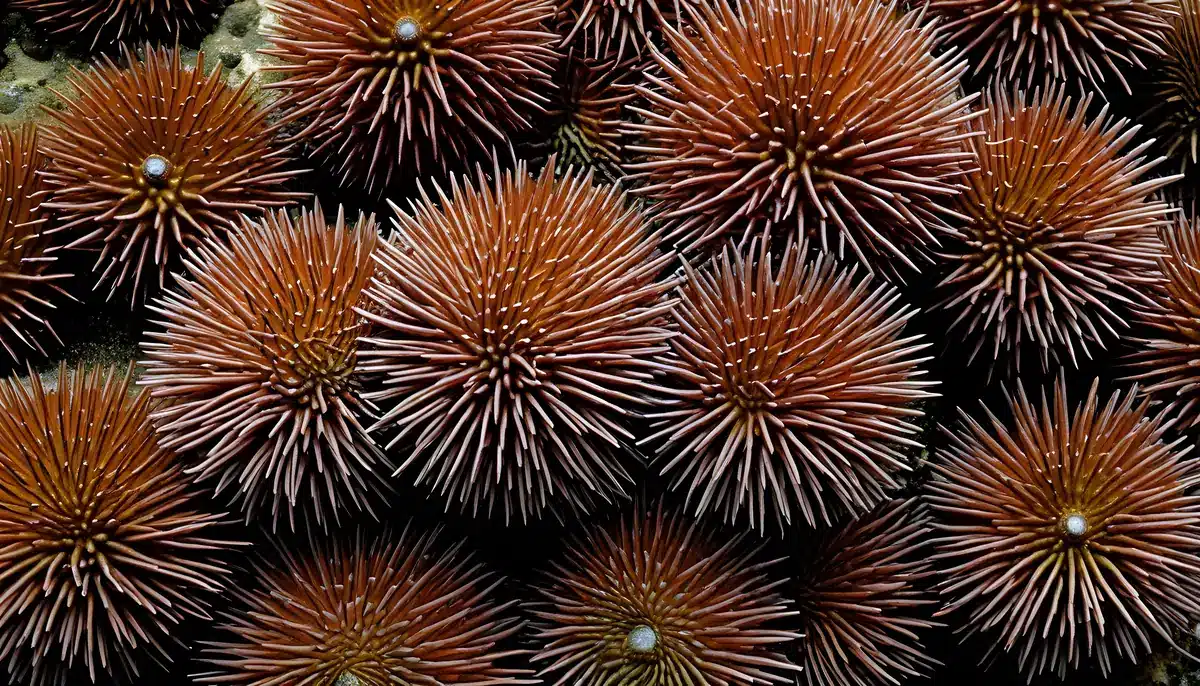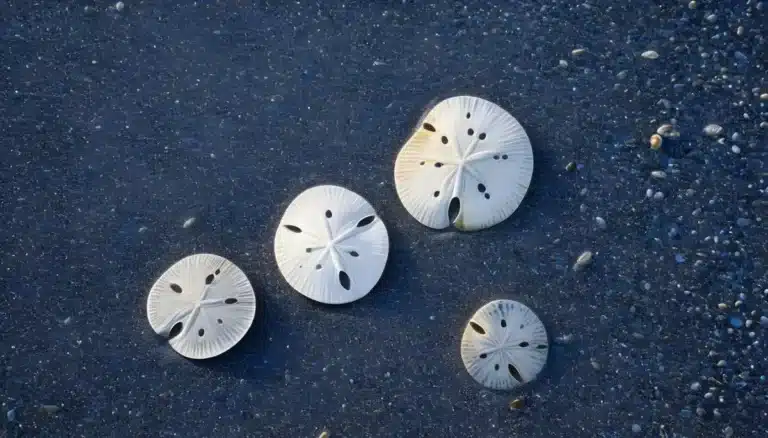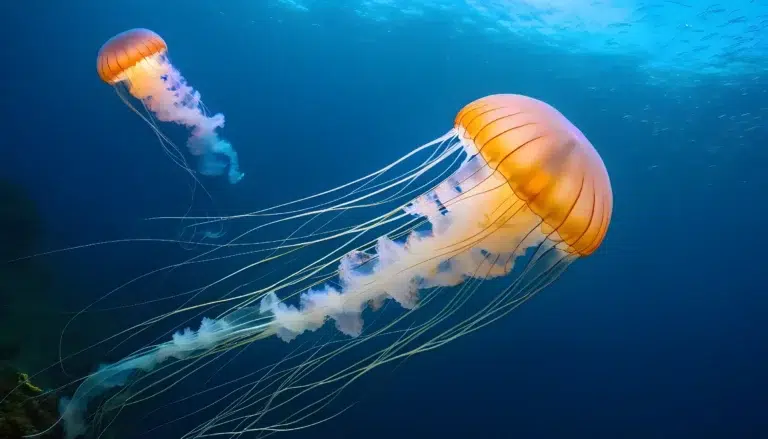Sea Urchins: Nature’s Spiky Marvels
Sea urchins belong to the phylum Echinodermata and the class Echinoidea, categorizing them as marine animals. They are characterized by their spherical, spiny bodies and are found in oceans around the world, from shallow waters to deep sea habitats. Sea urchins play important roles in marine ecosystems, feeding on algae and other small organisms, and serving as food for various marine predators. In addition, their hard, calcium carbonate shells, or tests, are often washed up on beaches and are prized by collectors. Some species of sea urchins are also considered a delicacy in certain cuisines.
Basics of Sea Urchins
Sea urchins are part of a group called Echinodermata, which includes sea stars, sea cucumbers, sand dollars, brittle stars, and crinoids. Just like these other sea creatures, sea urchins have a special kind of symmetry called pentamerism, meaning they have a five-part arrangement. They get around using lots of small, clear “tube feet” that can stick to things.
Biodiversity
- Green Sea Urchin (Strongylocentrotus droebachiensis):
- Lives in cold waters of the North Atlantic and North Pacific.
- Valued for its roe, known as uni in Japanese cuisine.
- Purple Sea Urchin (Strongylocentrotus purpuratus):
- Native to the eastern Pacific, from Alaska to Baja California.
- Important for maintaining kelp forest ecosystems by eating algae.
- Red Sea Urchin (Mesocentrotus franciscanus):
- Also called the giant red sea urchin.
- Found along the west coast of North America.
- Harvested for its roe, used in sushi and seafood dishes.
- Diadema Sea Urchin (Diadema antillarum):
- Found in the Atlantic and Caribbean.
- Known for its long, venomous spines and role in coral reef health.
- Collector Urchin (Tripneustes gratilla):
- Distributed in the Indo-Pacific region.
- Eats algae and detritus, helping control algal growth on coral reefs.
- Pencil Sea Urchin (Eucidaris tribuloides):
- Found in the Western Atlantic.
- Has long, pencil-like spines and is often in seagrass beds and rocky areas.
- Fire Urchin (Astropyga radiata):
- Inhabits coral reefs in the Indo-Pacific.
- Recognized by vibrant coloration and long, thin spines.
- Cake Urchin (Tamadara aequalis):
- Native to the Indo-Pacific.
- Named for its flattened, cake-like appearance.
- Slate Pencil Urchin (Heterocentrotus mamillatus):
- Found in the Indo-Pacific.
- Characterized by long, thin spines and distinctive coloration.
- Long-Spined Sea Urchin (Centrostephanus rodgersii):
- Native to Australia and New Zealand.
- Has long, venomous spines and can damage kelp forests if not controlled.
Size:
Sea urchins can be different sizes. Some are small and compact, while others are much bigger. For instance, the pencil sea urchin (Eucidaris tribuloides) is quite small, with a hard shell diameter of about 2 inches. On the other hand, the giant red sea urchin (Mesocentrotus franciscanus) can have a hard shell diameter of up to 7 inches or even more.
Shape:
Sea urchins have various shapes, ranging from round to slightly flat or stretched. The cake urchin (Tamadara aequalis) looks like a flattened disk, similar to a cake. The pencil sea urchin (Eucidaris tribuloides) has long, pencil-like spines that make it stand out. Some, like the collector urchin (Tripneustes gratilla), are more spherical in shape.
Spine Length and Arrangement:
Spines are a key feature of sea urchins, and they differ in length, thickness, and arrangement. The long-spined sea urchin (Centrostephanus rodgersii) has really long spines, reaching several inches. The fire urchin (Astropyga radiata) is known for its thin, colorful spines. The slate pencil urchin (Heterocentrotus mamillatus) has long, thin spines arranged uniquely.
Coloration:
Sea urchins come in many colors, from red, purple, and green to vibrant hues. The purple sea urchin (Strongylocentrotus purpuratus) is named for its deep purple color. The fire urchin (Astropyga radiata) has bright colors, including red or orange spines. The collector urchin (Tripneustes gratilla) can vary in color, from greenish-brown to reddish-brown.
Camouflage and Mimicry:
Some sea urchins use camouflage or mimicry to blend in. The collector urchin (Tripneustes gratilla) might have spines covered with algae, helping it blend into the reef. Certain species can change their color to match their surroundings, giving them protection against predators.
Ecological Importance
Sea urchins are vital contributors to marine ecosystems due to their role in controlling algal populations. As herbivores, they actively graze on algae, preventing excessive growth that might otherwise overwhelm coral reefs and disturb the delicate balance of the ecosystem. This herbivorous activity plays a crucial part in sustaining the health and diversity of marine habitats, ultimately supporting the overall stability and resilience of coastal ecosystems.
Reproduction and Life Cycle
For over 100 years, scientists have used sea urchins in research about cells and how living things grow. Sea urchins are really good at making eggs and sperm. It’s easy to make male and female sea urchins release lots of eggs or sperm. When the eggs come out, they’re ready to be fertilized by mixing them with sperm. The tiny baby sea urchins that result can be seen through because they grow in just seawater.
Scientists have a lot of information about the genes and molecules of different sea urchin types. They can quickly and repeatedly put things like genetic instructions, proteins, and colors into the eggs and embryos. In classrooms, people like using sea urchins to show live examples of how fertilization and early development happen.
Studying sea urchins has helped scientists learn a lot about how sperm and eggs work together, how eggs start growing, how cells grow and divide, the networks of genes involved in development, and how embryos and important reproductive cells are kept safe.
Culinary Delights and Commercial Uses
Japanese Cuisine (Uni):
In Japan, sea urchin roe is called “uni” and is considered a special treat. People love to enjoy uni when it’s fresh, either by itself or on top of sushi, sashimi, or rice bowls. Its rich, creamy texture and unique, salty flavor make uni a highly valued ingredient in fancy Japanese dining.
Mediterranean Cuisine:
In places like the Mediterranean, especially along the coasts, sea urchins are used in cooking. In Italy, they’re known as “ricci di mare,” and their roe is used in pasta dishes, sauces, or eaten on its own.
French Cuisine:
In French cooking, sea urchin roe is used to add a luxurious and unique flavor to dishes. Chefs might mix uni into sauces, custards, or use it as a fancy topping for seafood dishes.
Spanish Cuisine:
In Spain, sea urchins are called “erizos de mar,” and sometimes their roe is used in traditional seafood recipes.
Commercial Uses:
Sea urchins are important for businesses, especially in the fishing industry. People harvest sea urchins for their roe in places where they are plentiful and highly valued. Countries like Japan, the United States, Canada, and Chile are involved in catching and selling sea urchins, especially to meet the demand for uni in other parts of the world.
Global Demand:
People around the world really like sea urchin roe, especially in fancy food markets. Divers often go underwater to catch sea urchins, carefully take out their roe, and process it for cooking.
Sustainability Concerns:
Because many people want sea urchin roe, there are worries about catching too many and harming the environment. To address this, rules and practices for responsible fishing have been put in place. This helps make sure that sea urchins are caught in a way that keeps their populations healthy and maintains a good balance in nature.
Conservation Challenges
Overfishing:
Issue: Catching too many sea urchins for their roe, driven by high culinary demand, can harm populations and upset the natural balance.
Impact: Lower sea urchin numbers can lead to excessive algae growth, harming coral reefs and other marine homes.
Habitat Destruction:
Issue: Practices like destructive fishing, pollution, and climate change can damage sea urchin habitats, including coral reefs.
Impact: Less suitable homes mean less food and shelter for sea urchins, impacting their health and ability to keep ecosystems in balance.
Climate Change:
Issue: Changes in ocean conditions from climate change can affect sea urchin development, reproduction, and survival.
Impact: Stress from climate changes can weaken sea urchin populations, making them more susceptible to other threats.
Sustainable Practices:
Need: It’s crucial to fish sustainably to prevent overharvesting and keep sea urchin populations healthy.
Impact: Regulated quotas, size limits, and protected areas as part of sustainable practices can ensure sea urchins thrive and prevent harm to marine ecosystems.
Ecosystem-Based Management:
Approach: We need a management approach that looks at how sea urchins interact with their environment.
Impact: Understanding the bigger picture helps conserve sea urchins and keeps coral reefs and other habitats healthy.
Education and Awareness:
Action: Spreading awareness about sea urchins’ role in marine ecosystems and the dangers of overfishing is essential.
Impact: Informed communities and industries are more likely to support sustainable practices, aiding sea urchin conservation.
Research and Monitoring:
Action: Regularly studying sea urchin populations, their homes, and human impacts is crucial.
Impact: Scientific data helps create effective conservation plans, adjusting management practices to changing conditions.
Conclusion
Overfishing:
Issue: Catching too many sea urchins for their roe, driven by high culinary demand, can harm populations and upset the natural balance.
Impact: Lower sea urchin numbers can lead to excessive algae growth, harming coral reefs and other marine homes.
Habitat Destruction:
Issue: Practices like destructive fishing, pollution, and climate change can damage sea urchin habitats, including coral reefs.
Impact: Less suitable homes mean less food and shelter for sea urchins, impacting their health and ability to keep ecosystems in balance.
Climate Change:
Issue: Changes in ocean conditions from climate change can affect sea urchin development, reproduction, and survival.
Impact: Stress from climate changes can weaken sea urchin populations, making them more susceptible to other threats.
Sustainable Practices:
Need: It’s crucial to fish sustainably to prevent overharvesting and keep sea urchin populations healthy.
Impact: Regulated quotas, size limits, and protected areas as part of sustainable practices can ensure sea urchins thrive and prevent harm to marine ecosystems.
Ecosystem-Based Management:
Approach: We need a management approach that looks at how sea urchins interact with their environment.
Impact: Understanding the bigger picture helps conserve sea urchins and keeps coral reefs and other habitats healthy.
Education and Awareness:
Action: Spreading awareness about sea urchins’ role in marine ecosystems and the dangers of overfishing is essential.
Impact: Informed communities and industries are more likely to support sustainable practices, aiding sea urchin conservation.
Research and Monitoring:
Action: Regularly studying sea urchin populations, their homes, and human impacts is crucial.
Impact: Scientific data helps create effective conservation plans, adjusting management practices to changing conditions.



